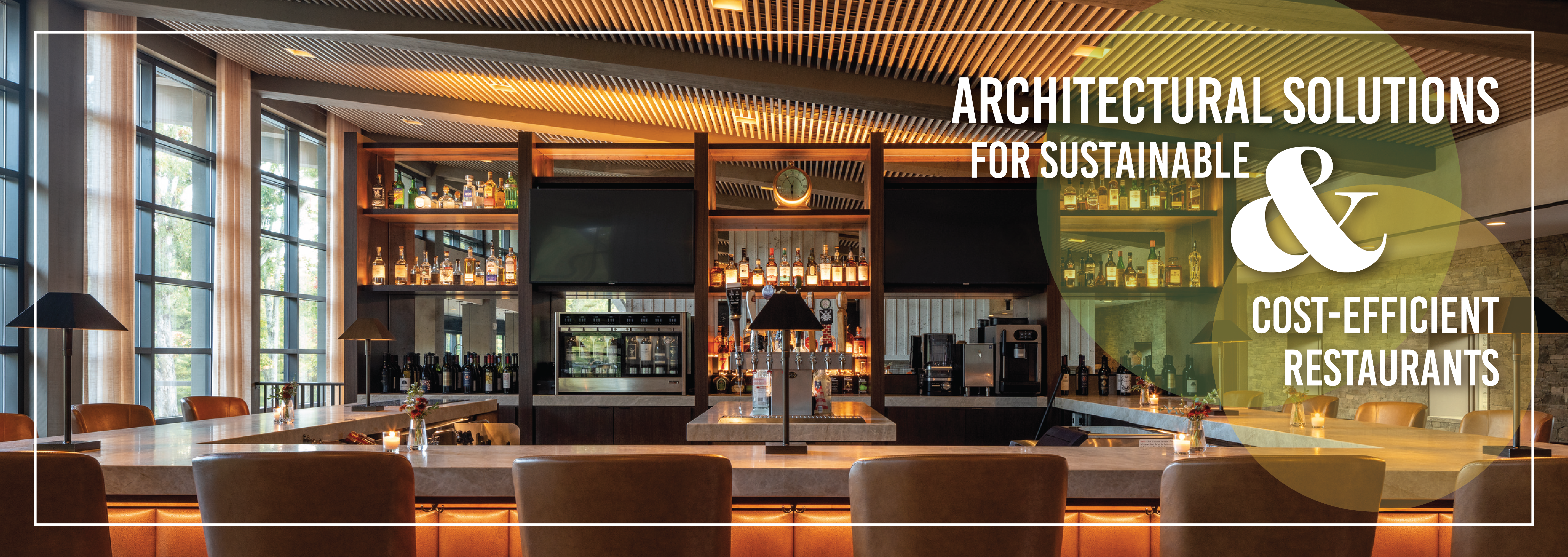Municipalities within the United States are implementing laws to help reduce their carbon footprints and increase sustainability initiatives in all areas of design, including commercial kitchens. As the momentum for sustainable design grows, The Johnson Studio at Cooper Carry can help restaurateurs plan memorable dining spaces that reduce their environmental impact while staying profitable.
Site and Exterior Opportunities
Sustainable restaurant design begins with the accessibility of the establishment. Choosing a site that is easily accessible by pedestrians, cyclists, and mass transit users promotes sustainable transportation options. Areas with good pedestrian infrastructure and proximity to public transportation reduces the reliance on cars and minimizes carbon emissions.
TWO Urban Licks in Atlanta optimizes accessibility, as it is situated on the BeltLine, a former railway corridor turned active bicycle/pedestrian loop. The restaurant’s location along the Eastside Trail adds to its charm, attracting both locals and visitors who enjoy the vibrant atmosphere and the convenience of access from the trail.
To maximize freely available natural resources, building orientation and proper window and skylight placement can leverage natural light, even in the kitchen. Natural lighting not only enhances the aesthetic appeal of the restaurant but also provides health benefits for guests and creates a connection with the surrounding environment—without impacting the electric bill, of course.
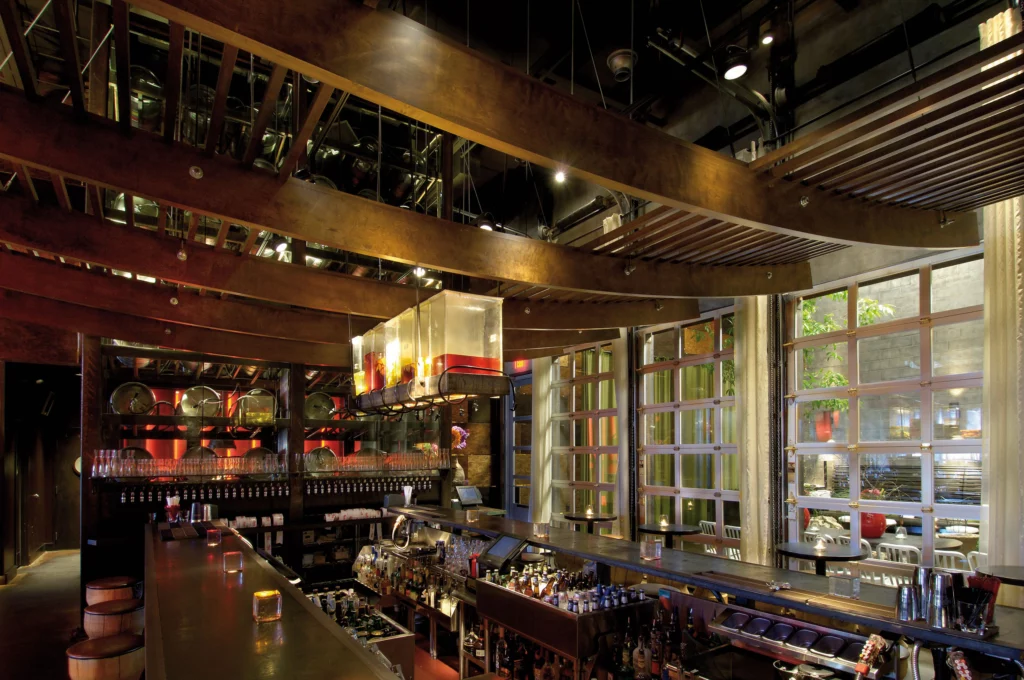
At The Eldred Preserve, our team embraced daylight as a core component of the architectural vision. Expansive windows allow sunlight to permeate the interior spaces, creating a warm and inviting ambiance during the day and providing guests with a unique connection to the surrounding natural environment. The 26-foot-tall windows frame breathtaking views of the Catskills, and open-air terraces immerse visitors in the tranquility of the landscape as they dine al fresco.
Not only can harnessing renewable energy sources save money on the electric bill, but it can even help a restaurant become energy positive. Incorporating photovoltaic (PV) panels harnesses solar power, allowing restaurants to reduce their dependence on traditional energy sources and lower their carbon footprint. The cost of PV panels continues to drop, making them a more affordable option for businesses. Additionally, there are many state and federal tax incentives for renewable energy, further offsetting the initial investment and providing long-term cost savings.
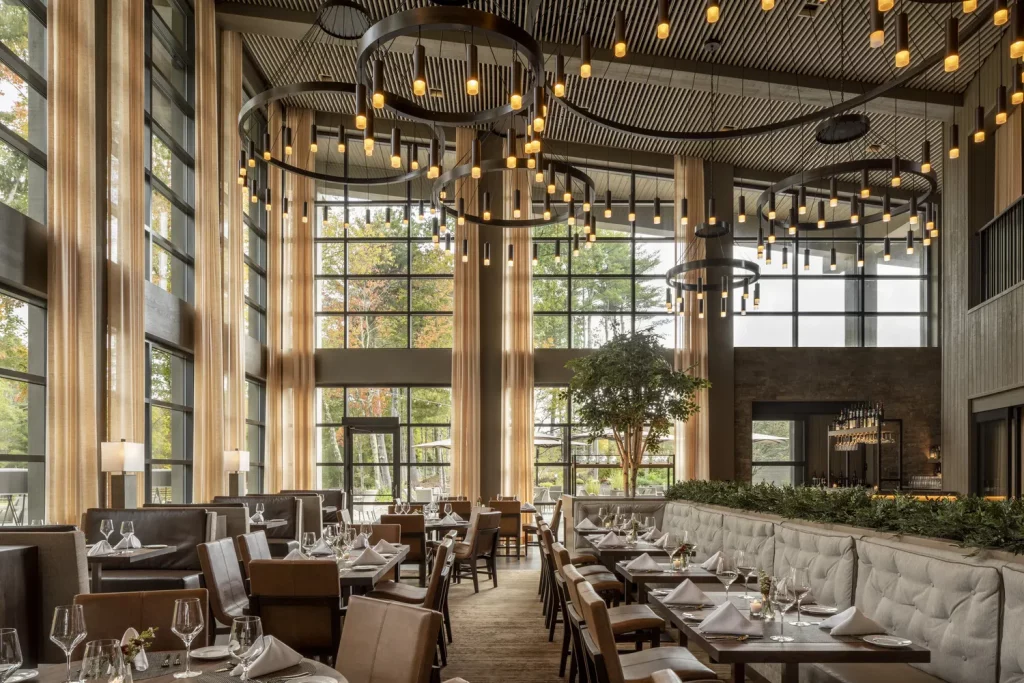
Eco-Friendly Building Materials
Where new construction is required, certified sustainable materials should be used. Opting for materials that have been certified as sustainable promotes environmental responsibility without necessarily increasing the cost of construction. Designers and builders should look for certifications like Forest Stewardship Council (FSC) for wood products, Cradle to Cradle (C2C) for overall sustainability, and Green Seal for general building materials.
When possible, designers and builders should try to use locally sourced, reclaimed materials. By utilizing materials that have been salvaged or reclaimed from previous projects, restaurants can reduce waste and support the local economy. Incorporating these materials into the design adds a unique placemaking touch to the restaurant, while reducing the environmental impact associated with extracting and producing new materials.
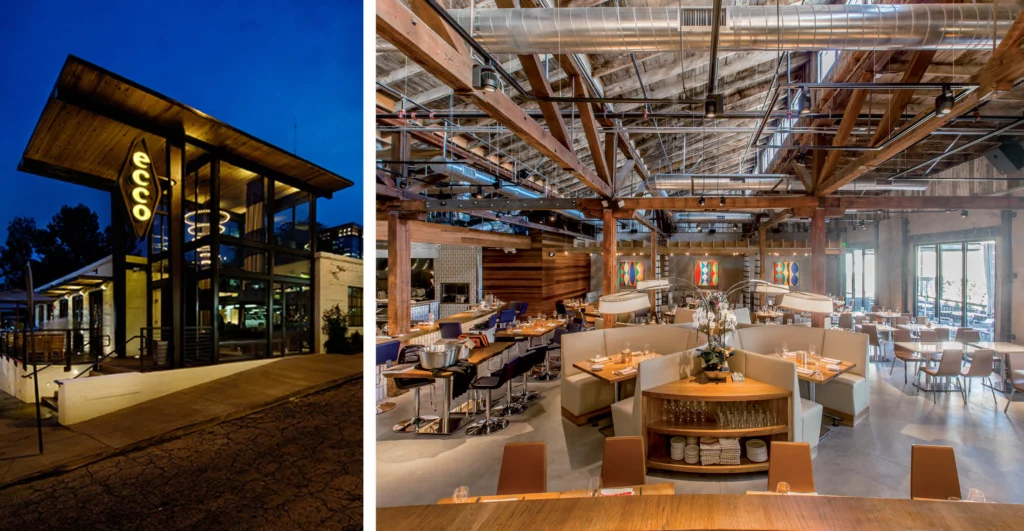
Beyond building materials, restaurateurs should find opportunities for adaptive reuse, which involves repurposing existing structures or buildings instead of constructing new ones. By reimagining and renovating old buildings, restaurants can reduce construction waste and minimize the environmental impact associated with new construction. In some cases, adaptive reuse can result in 80% less embodied carbon, compared to new construction of the same size. Adaptive reuse not only promotes sustainability but also adds character and uniqueness to the restaurant’s design.
At Ecco Midtown, we married Old World European elegance with a mid-century New World vibe, all in the context of an unused warehouse building. Exposed masonry walls and steel beams create a raw and urban backdrop, adding a sense of character and authenticity to the space. These industrial elements are softened by warm wood finishes, plush furnishings, and carefully curated artwork, striking a perfect balance between rugged and refined aesthetics. Similarly at Juniper & Ivy, we turned a deteriorating industrial building located in San Diego’s Little Italy neighborhood into celebrity chef Richard Blais’s cosmopolitan new restaurant. The original sawtooth skylights, concrete walls, and wood trusses were restored and now feature prominently as the stage setting for this Michelin-recognized restaurant.
A New Era of Kitchen Equipment
Naturally, sustainable restaurant design goes beyond the dining area and extends to the kitchen. Building Green estimates that commercial kitchens consume approximately five times the energy per square foot of a standard office. Opting for induction cooking instead of gas stoves offers many significant benefits. Induction cooking is 85% energy efficient or better (compared to 32% for gas), faster, and safer.
By not burning gas, all harmful combustion byproducts are eliminated, including carbon monoxide, nitrogen dioxide, and formaldehyde. Further, induction cooking reduces energy waste and offers precise temperature control, resulting in less heat loss and more efficient cooking operations, which translates to higher throughput. Less wasted heat also means a comfortable working environment in the kitchen and far less air conditioning. Especially in new construction, all-electric kitchens can provide substantial savings, as owners do not have to pay for a new gas utility connection.
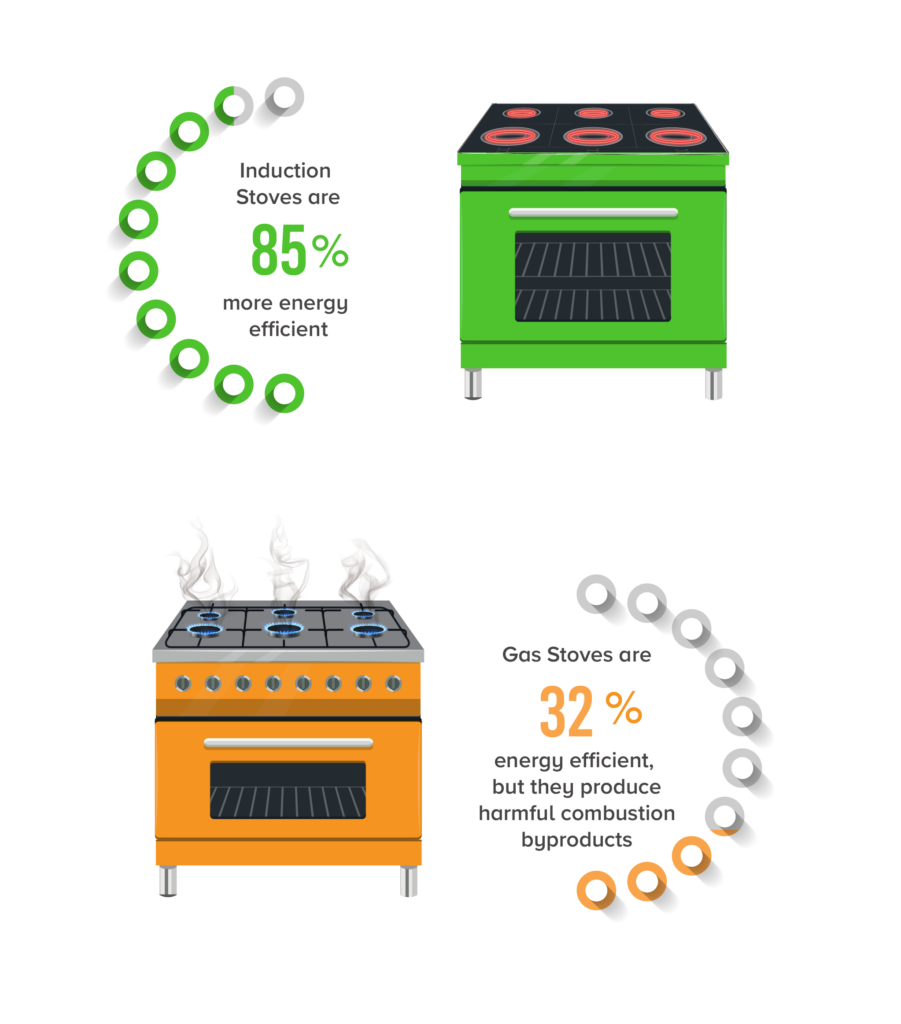
Legendary chefs Eric Ripert, Heston Blumenthal, Daniel Boulud, and Alain Ducasse have spoken out about the culinary benefits of induction cooking for years, and global corporations are eliminating gas from their campuses. Google is committed to operating entirely on carbon-free energy by 2030 and has installed all-electric kitchens in all their newest buildings. The modernization of Microsoft’s corporate campus in Redmond, WA includes One Esterra Food Hall, an all-electric cafeteria that opened in March 2022.
There are two drawbacks of moving to induction cooking. The first is cost, as kitchens need to be retrofitted to accommodate for the new appliances. However, lower monthly operational bills can help curb the cost. Further, because pan temperatures react to user adjustments quickly on induction ranges, there is less wear and tear on pots and pans because high temperatures do not scorch them. Many pans that work on gas stoves will also work on induction ranges, such as cast iron and stainless steel. The costs of purchasing an induction range can be cushioned by the fact that the chef is no longer buying pans every two years because they are scorched.
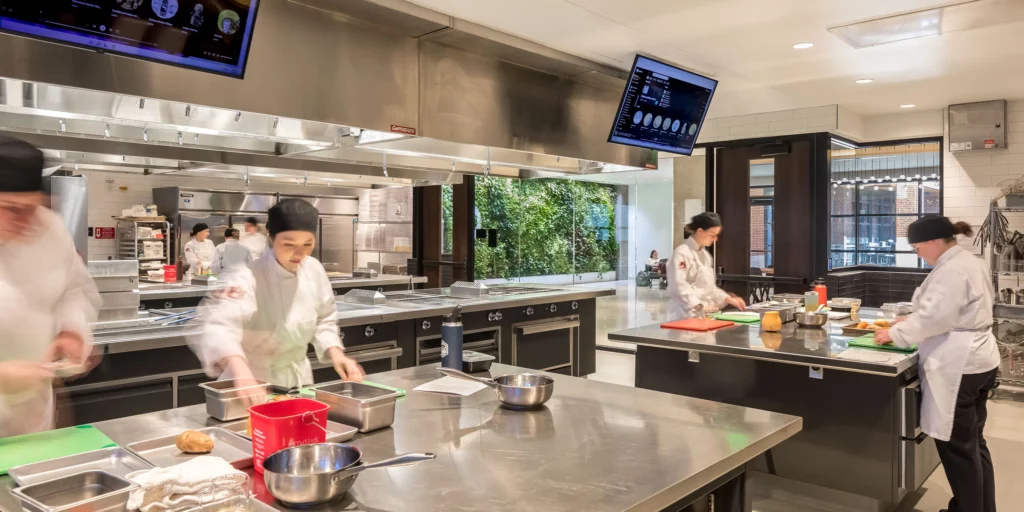
The other major drawback of moving to induction cooking is upskilling; chefs will need to be trained to adapt to this modern way of cooking. To ensure a seamless shift to electric kitchens without compromising food quality, it is important to have early conversations and training that address such concerns. It is also key to involve all relevant stakeholders in the planning process, including third-party organizations that manage dining operations, so all are on the same page with a training plan. Some higher education institutions are adopting a green lease food service agreement as a way to transition to electric kitchens.
To enhance energy efficiency, demand-control ventilation systems can be implemented that only operate when needed, eliminating excessive fan power as well as noise. Newer hoods can recapture and reuse heat from the kitchen ventilation system, reducing the energy needed to heat the building.
Other smart equipment solutions include dishwashers and warewashers with heat recovery. Ventless dishwashers use less water compared to traditional models and produce minimal steam. Advanced warewashers recover and reuse hot water from the dishwasher’s drain, reducing the need for additional hot water supply. By reducing steam production and optimizing the use of waste heat, restaurants can minimize energy consumption and further decrease the HVAC load.
Final Thoughts
Through sustainable design, restaurants can significantly reduce their environmental footprint and operating costs. Moreover, they can enhance the dining experience for guests, attract environmentally conscious customers, and contribute to a more sustainable future for the food service industry. Embracing sustainable practices is not only the responsible choice but also a strategic decision that aligns with the growing financial and market pressures on the industry.
Connect with The Johnson Studio at Cooper Carry to help you blend sustainability and F&B design.
